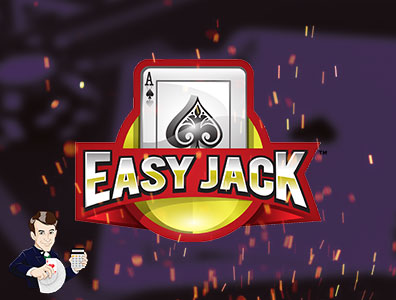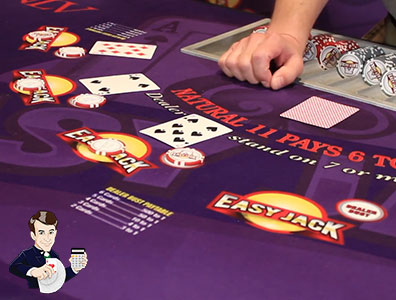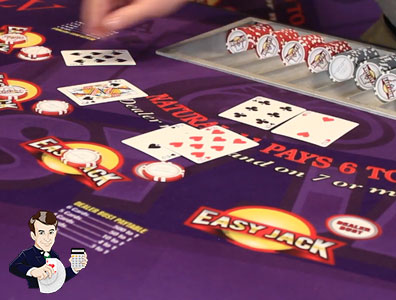Video Review of Easy Jack
Mike interviews Matthew Stream about his game Easy Jack at the 2018 Cutting Edge Table Games Conference in Las Vegas. Not only do we have an interview about the game, but a full analysis too, which Mike wrote after it field trialed at Harrah's in Las Vegas.
Hi, this is Mike Shackleford at the 2018 cutting edge table game show at the Paris Casino in Las Vegas, and I'm joined by Matthew Stream representing his game Easy Jack. Matthew I saw this game before at-- It was the Flamingo right?

[00:00:39] Matthew Stream: Harris.
[00:00:40] Mike: I played this at Harris, I already write about it on my site. I really think it's a very clever simplification of blackjack, but for my readers who haven't seen my analysis or played it yet can you describe the game to me?
[00:00:52] Matthew: Absolutely. Essentially Easy Jack is a one-card blackjack game. Everybody starts with one card instead of two cards. The goal is to get closer to 11 than the dealer without going over. If you go over 11 it's a bust, just like going over 21 in blackjack. If you're dealt an ace as your first card that's a natural 11, treated just as a blackjack, and you're either paid 3 to 2 or 6 to 5 depending on what the casino prefers.
[00:01:16] Mike: All right. I take it it's just hitting and standing, right?
[00:01:19] Matthew: Simple hit or stay game, yes sir.
[00:01:21] Mike: There's no dealer up card right?
[00:01:23] Matthew: The dealer's card is dealt face down. All the players' cards will be dealt face up. After all the players have acted the dealer will expose their card. If the dealer has a total of 6 or less they will continue to hit until they have a total of 7 or more.
[00:01:36] Mike: I take it that's the dealer strategy. What is the correct player strategy?
[00:01:43] Matthew: It's essentially the same with one small variation, which is actually pretty amusing how close it is. If you have a single card 6 or less, you're going to want to hit. If you have multiple cards that total 5 or less, you're going to want to hit, so that 6 is the borderline. If it's a single-card hit, multiple-cards 6 you're going to stand.

[00:02:04] Mike: By the way that is similar to the situation with a 16 against the 10 in blackjack. If your 16 is composed of two cards you should hit it. If it's composed of three or more cards then you should stand on it.
[00:02:17] Matthew: Is that what I've been doing wrong this whole time? [laughs]
[00:02:19] Mike: It's a super super minor thing. It's only going to help you a tiny little bit at the tables, but 16 against a 10 is a super borderline in blackjack, right?.
[00:02:30] Matthew: It's a rough outcome either way. You're just in the worst of situations.
[00:02:34] Mike: If surrender is an option you should definitely take it.
[00:02:36] Matthew: Absolutely.
[00:02:37] Mike: All right. Well, do you mind if we play a few rounds as an example?
[00:02:41] Matthew: It would be my pleasure. Players please place your bets. All right, any side wagers? Very good luck. 7, hit, bust. We're going to take the base wager. You still have a chance to win the side bet. 5, 15 too many. Stay with 10. Dealer shows a 10 and stays. No bust. Push.

All right, last call…
Good luck. 8, hit 6, 16, bust. Dealer shows a 10. No bust? 8 loses, 8 loses. Very good luck. There we go. This is a natural 11. In the 6 to 5 version you would be paid immediately, and we'd keep the card out to represent the side wager still being in play.
5, hit, 15. That is a bust and 14. Dealer shows a 4, must hit until we make a total of 7 or more, we have busted with two cards paying 3 to 1. Very good luck. 10, stand, 9 and 2. 7, stand. Dealer shows a 6, must hit. 8, no bust, 7 loses, 9 wins, 10 wins.
[00:04:58] Mike: One more round.
[00:04:59] Matthew: Yes sir. Very good luck. 2, hit, 10, very nice. 10 and 8 stays. Dealer shows a 2, dealer has 8 and stays. No bust, 8 pushes, 10 wins and 10 wins. Players please place your bets. Very good luck. Stay with 10, dealer shows a 2, must hit. 3, 5 and 12. We have a four-card bust. 10 wins and four cards pays 10 to 1.
[00:05:47] Mike: Matthew, thank you very much for that demonstration. Can you tell me a little bit about the math of the game? What is the house advantage?
[00:05:53] Matthew: With the 3 to 2 version, where the players' ace and the dealer's ace would compete, that is a 0.94% house edge, so just under 1%. In the 6 to 5 version where the players' ace is paid immediately 6 to 5, that's a 2.4% house edge. With the players making a lot fewer mistakes in this game, it's a little more acceptable to get a slightly higher house edge in there rather than going for something too low. At the same time high hands per hour leave it where you don't want to go too high.
[00:06:22] Mike: All right. How about that dealer bust pay table side bet?
[00:06:26] Matthew: Nine and a half percent which is, from why understanding, becoming more and more the common right around 10% even upwards of that with some of these new side wagers for blackjack and other table games. I feel like I'm in the right ballpark.
[00:06:37] Mike: All right. Well thanks again for showing me the game.
[00:06:40] Matthew: Thank you very much Mike.
[00:06:41] Mike: Bye everyone.




